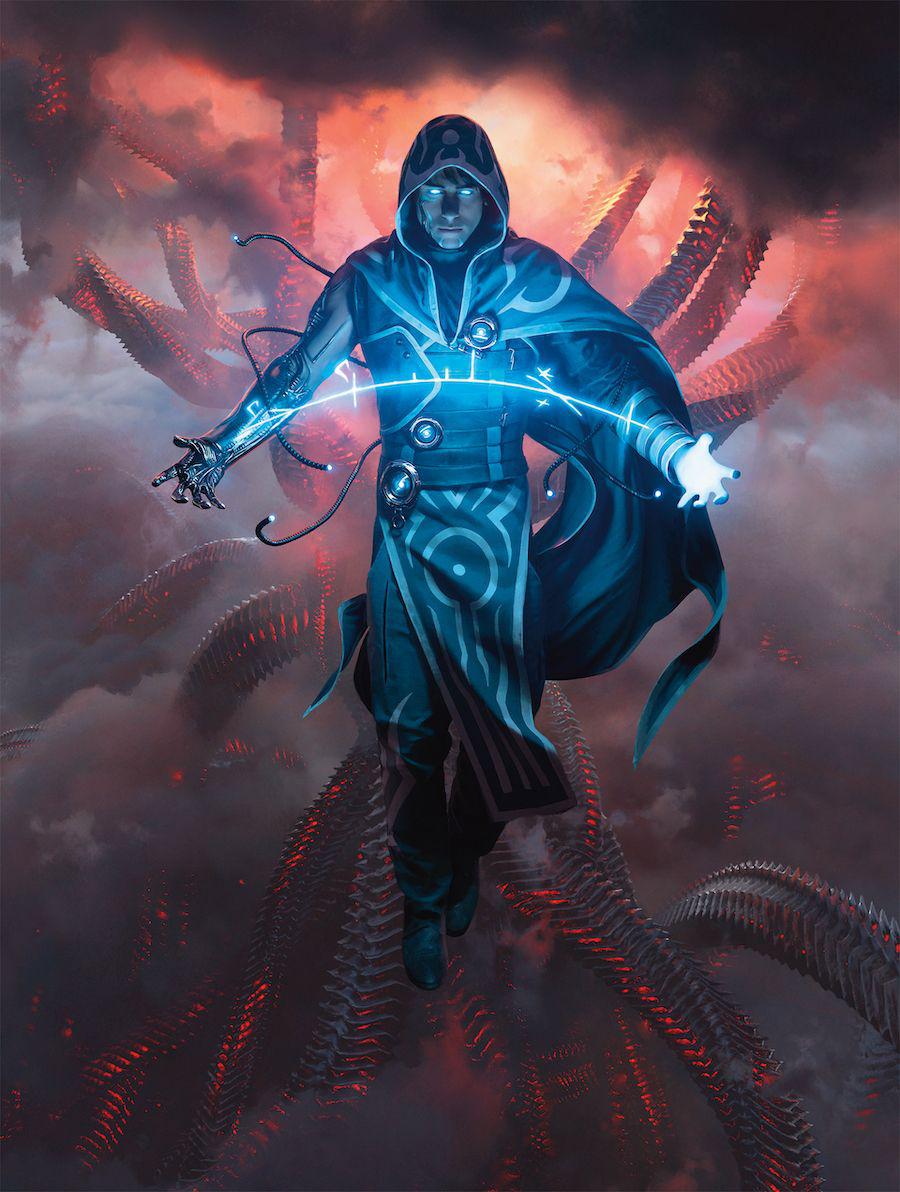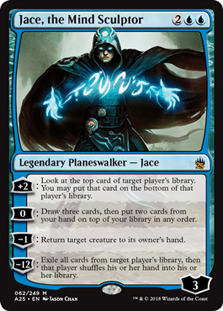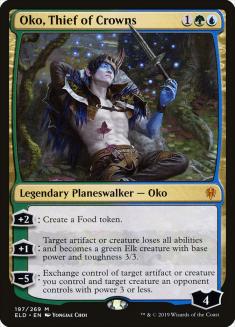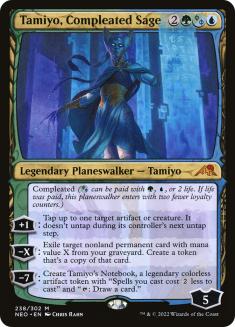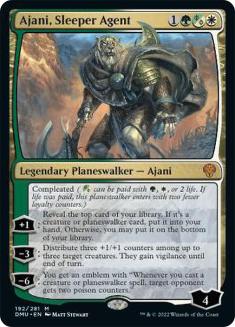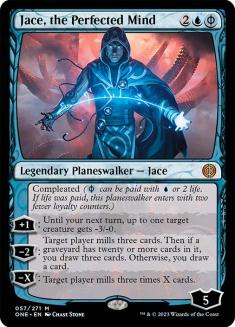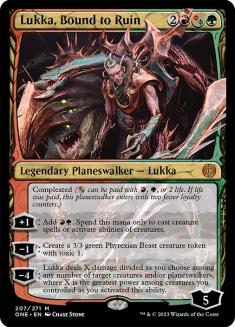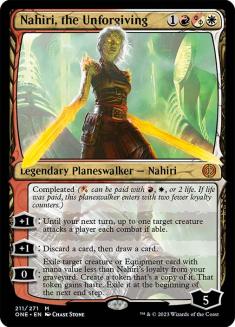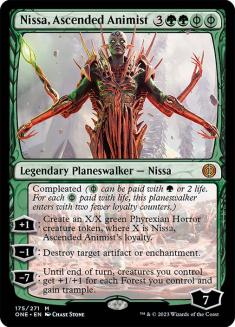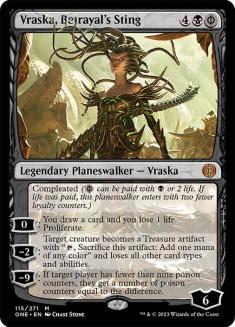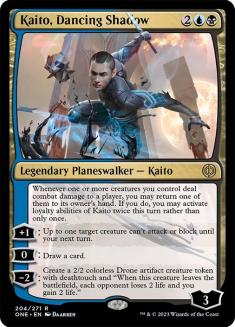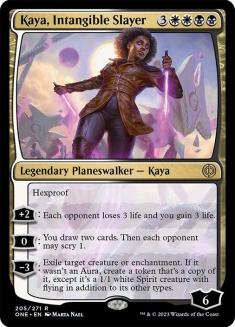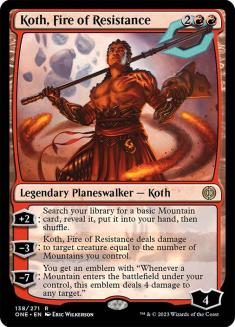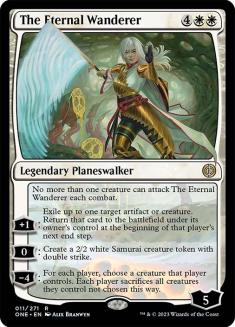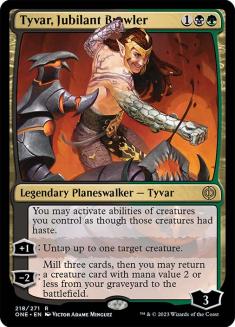Hello once again, gamers! I hope everybody had a good Cubemas! For now, it’s time to shelve the Vintage Cube talk as we look ahead to the release of Phyrexia: All Will Be One. We don’t have the full set preview just yet, but there’s already a ton to talk about regarding the set. With the above-average saturation of planeswalkers and all ten planeswalker cards already previewed, I figured that would be a good topic to tackle this week!
The Modest Planeswalker
Planeswalkers are likely the most contentious card type in Magic, beloved in some circles and hated in others, which means that they’re doing their job. You want cards that people love, but it’s impossible to get love from a large audience without drawing some ire along with it. Personally, I consider planeswalkers to be one of the most significant upgrades to the experience of Cubing of all time, with a handful of problematic individual designs affecting player perspectives on the card type broadly.
The best planeswalkers can be absolutely dominant if introduced to the wrong Cube environment, and even some cards that are a little weaker in the average Cube get a bad rap for the negative impact that they’ve had on Constructed. I don’t find Teferi, Time Raveler to be especially powerful in most Cubes, but I’m fully aware that it’s the sort of card that gets a lot of glares and vitriol.
I adore cards like Garruk Wildspeaker; Elspeth, Knight-Errant; and Vraska, Golgari Queen, though. They generate value, give your opponent something to worry about, and give you at least a little something for your trouble if the opponent can answer them easily. This package links to combat by virtue of the way planeswalker loyalty works mechanically. If you’re a planeswalker hater, there might not be much for your consideration in today’s article, but if you’re a fan of modest planeswalkers like me, then I’d like to share my thoughts on the crop of incoming planeswalkers in Phyrexia: All Will Be One.
Compleated vs. Original Recipe
The first thing to examine regarding the new planeswalkers is that half of them feature the compleated keyword that we first saw on Tamiyo, Compleated Sage. I found that Tamiyo to be solid even in Vintage Cube and a great option for medium- to high-powered Cubes. We’ve also seen the mechanic on Ajani, Sleeper Agent, which showed off an example of a weaker planeswalker with the ability.
When evaluating planeswalkers with this ability, it generally makes sense to look at the card in terms of paying all the mana and no life first. This is not because two life is significant, but rather because losing two loyalty is.
All the compleated designs seem to be balanced around paying full retail and having the Phyrexian life option as a different mode that’s available in a pinch. There will be games where you’re thrilled to have the option and being compleated is absolutely upside over not having the ability, but it is clear that you’ll want to be spending mana more often than not on most of these cards.
Beyond that, we’re looking for all the usual things we want to see on a planeswalker: the ability to protect itself, the ability to generate card advantage and/or impact the battlefield, and having loyalty numbers that justify the casting cost. By these metrics, we can see that Tamiyo is great and understand why Ajani is a bit of a miss.
The Phyrexian Side
That in mind, let’s take a look at our five new compleated planeswalkers:
Jace, the Perfected Mind
We’ll start with the absolute worst of the bunch in terms of good Cube gameplay. I have a much lower tolerance for mill than the average Cuber, but almost all of us can agree that Jace, Memory Adept is right out for Cube consideration. Jace, the Perfected Mind is a similar style of card that is much more for Constructed than Cube.
There are ways to make the card fit better or worse in a Cube. Environments where players play more cards could definitely work. The -2 actually starts to look pretty cool if we’re talking about Commander Cube. If Jace is a good fit for your Cube, then we’re probably not talking about a singleton environment where players play 40 cards, and you know more about your Cube than I do. There’s not much else for me to say on this one.
Lukka, Bound to Ruin
A lot of people are comparing Lukka, Bound to Ruin to Garruk Wildspeaker, which, you know… makes sense. It “makes two mana” and 3/3s for the same loyalty numbers. As a four-mana play, Lukka is much weaker than Garruk, though, because using that two mana to cast a noncreature spell is much more powerful than being limited to creatures, especially if we’re talking about leaving up an instant. Not to mention that you have to be Gruul to cast Lukka, which is a pretty undesirable ask in a lot of Cubes. Of course, if all you care about is ramping right to a seven-mana creature, Lukka will accomplish that for you.
Where Lukka shines is in the ability to cast it for five mana and immediately use the -4. That’ll be a great removal spell in a lot of games that leaves a planeswalker behind, which is hard to argue with. That won’t be on the level of Vintage Cube or realistically a Legacy Cube – again, the card is still considerably behind Garruk Wildspeaker on power level – but this makes Lukka a reasonable option for medium-powered environments.
Nahiri, the Unforgiving
I’ve seen chatter about Nahiri being a potential Modern contender, which I can’t really speak to. I can say that, in terms of Cube play, it’s pretty loud how safe they played it with this card. The abilities are cool, but you’re not building to any kind of ultimate and the card doesn’t really impact the battlefield in a permanent way on its own. The similarities to Ajani, Sleeper Agent are loud, and this one is really only going to fit into lower- to medium-power Cubes.
Nissa, Ascended Animist
Now this is a planeswalker! Wrenn and Seven had a short stint of being horrible but bordering on playable in the Magic Online (MTGO) Vintage Cube, and Nissa, Ascended Animist does the relevant things that that card does better and then does more things!
Nissa is a little weak on five mana, costing four life and either netting you four loyalty and a 4/4 or two loyalty and a Naturalize. As a fan of Vivien Reid, I’m into that, but I don’t love the loss of four life there. The numbers get much better when you pay six mana, and you’ve really got a card once you pay the whole seven! That’s also the point where you can just immediately use the -7 ability and probably win the game that turn. You can’t tutor for Nissa in the many ways that you can tutor for a Craterhoof Behemoth, but drawing it naturally gives you a card with a lot of similarities to very strong cards.
This is a slam dunk for me for the MTGO Vintage Cube, a definitely Legacy-power-level Cube contender, and more likely to be more powerful for other Cubes than not strong enough. The modality offered by compleation makes the card very interesting to me, and I look forward to playing this one a lot in higher-powered Cubes.
Vraska, Betrayal’s Sting
At five mana, Vraska, Betrayal’s Sting bears a lot of similarities to Lolth, Spider Queen. Lolth will fit better in an environment with a heavy sacrifice theme, and Vraska is more of a Proliferate Cube kind of card. I love Vraska in a medium- to high-power planeswalker-heavy environment. I should also note that the comparison to Lolth is high praise, as I do see Lolth as a solid Legacy Cube contender.
Vraska stands out over the other compleated planeswalkers because I imagine you’ll want to cast the card by paying life more often than not and just get going, either answering an opposing threat or drawing cards and proliferating. Vraska’s ultimate is quite forgettable, but everything else going on here is strong. I don’t see the card hacking it in Vintage Cube, much like the aforementioned Lolth, but I’m sure it will be a popular option elsewhere.
For Mirrodin!
Kaito, Dancing Shadow
Kaito, Dancing Shadow is a significant downgrade from Kaito Shizuki, but there’s room to be worse than a card that quickly demonstrated its Vintage Cube chops while still being playable. Kaito impacts the battlefield and generates card advantage, though admittedly the loyalty numbers are a little low. I’m not really concerned about the lack of an ultimate, but rather see having three options that you can always use when you cast the card as significant upside.
Four mana and two colors will get us into really contested space for Vintage Cube, though I’m sure Kaito, Dancing Shadow would make a fair amount of my MTGO Vintage Cube decks. Using the static ability to pick up Baleful Strix or creatures with other enters-the-battlefield abilities is quite powerful, and Kaito will really shine in any Cube featuring Ninjas.
Kaito reads to me as a card that scales quite well with its environment. The one-sided Howling Mine means that the card can hang in Vintage Cube, while the numbers are modest in a way where the card won’t be too powerful for other environments. I like this card more the more I think about it, and really love it for medium- to high-powered Cubes. A slam dunk for Cubes like the original Twobert.
Kaya, Intangible Slayer
I more or less dismissed Kaya, Intangible Slayer out of hand for being a seven-mana Orzhov card, but looking at it now, I’m starting to see the shine. Hexproof is pretty significant in terms of saving Kaya from burn and Hero’s Downfall effects, and while the +2 is wholly unremarkable on a seven-mana card, this is another planeswalker that immediately gives you two options, with the others being good.
Drawing two cards and offering your opponent a scry in exchange is actually really awesome. And going down to three loyalty for the -3 is actually pretty reasonable when Kaya can’t be targeted by Lightning Bolt! If you happen to grab a creature with an enters-the-battlefield ability, then Kaya could be a massive swing on resolution. The casting cost is pretty restrictive, but I would compare resolving this one favorably to Karn Liberated in Cube.
I don’t see Kaya hacking it in Vintage Cube, and the more combo- and/or counterspell-style cards are in your Cube, the less relevant a card like this will be, but I do see Kaya as a powerful option for more midrange and medium-powered Cubes.
Koth, Fire of Resistance
I would have been furious to see Koth compleated, so I was very relieved to see that’s not the case. I don’t have a lot of other positive things to say about this card. Koth, Fire of Resistance has abilities that leave the card mostly playable only in mono-red decks without being great in aggressive shells. That’s an oil and water combination, not peanut butter and chocolate.
I will say that the loyalty numbers are high, so if you have a Cube that is at a generally more modest power level and/or supports a midrange mono-red deck, then go nuts! I will say that there’s a part of me that’s very interested in combining this Koth with Chandra, Acolyte of Flame and Light Up the Night.
The Eternal Wanderer
I’m going to call that The Eternal Wanderer compares unfavorably to Elspeth, Sun’s Champion, but generally favorably to any other white six-drop. The +1 will be very strong in the right situation, though whether to include this card in your Cube will have less to do with whether the +1 is good and more to do with how backbreaking the -4 can be. Having a powerful sweeper just ready to go on a planeswalker that generates value otherwise is a scary proposition, even at six mana.
The Eternal Wanderer is more of an Arena Cube card than a Vintage Cube card, and I fully expect it to show up and be a significant factor in games there. The card is a definite haymaker for midrange slugfests, though not much of a player in Cubes that care less about combat.
Tyvar, Jubilant Brawler
Now and again we see Glimpse of Nature attempted as a support Cube card and archetype, and Tyvar, Jubilant Brawler’s static ability is very meaningful to helping decks full of mana creatures continue to cast spells. The static can definitely come up in more subtle ways, but I don’t find it all that exciting generally.
The +1 is nice for doubling up on a mana creature, or just giving something pseudo-vigilance is fine, too. I like that the -2 returns the creature to the battlefield, though the mana value restriction and generally low loyalty numbers of this card make Tyvar less a strong Golgari card and more an archetype-specific option in terms of Cube. Tyvar seems quite good in terms of supporting delirium and being a role player with sacrifice themes. If you’re a fan of Devoted Druid like Ryan Saxe, then Tyvar is definitely worth a look for the ability to recur the Druid and Vizier of Remedies.
Tyvar is certainly not a Vintage Cube-caliber card, but at three mana I think that it could be a good fit for high-powered Cubes that can really do something degenerate with one or more of the card’s abilities. Tyvar is at a low enough power level at a standalone card that it could fit into lower-powered environments where other planeswalkers wouldn’t, though I would want to see some cards alongside it that make sense of the card’s abilities beyond the idea being that they’re good enough on their own. The card is a great fit for Spooky Cube for playing well with delirium and sacrifice.
Planeswalkers, Cubed
I’m really looking forward to Phyrexia: All Will Be One and many of the set’s planeswalkers for Cube. These designs fit into a range of different power levels all the way up to Vintage Cube without any of them looking oppressive. Mill Jace is the only real miss for me for Cube, but the card will absolutely be plenty popular otherwise. Join me next week when I break down my Top 10 most Cubeable cards from Phyrexia: All Will Be One, and find out along with me if any of these planeswalkers made the cut!

